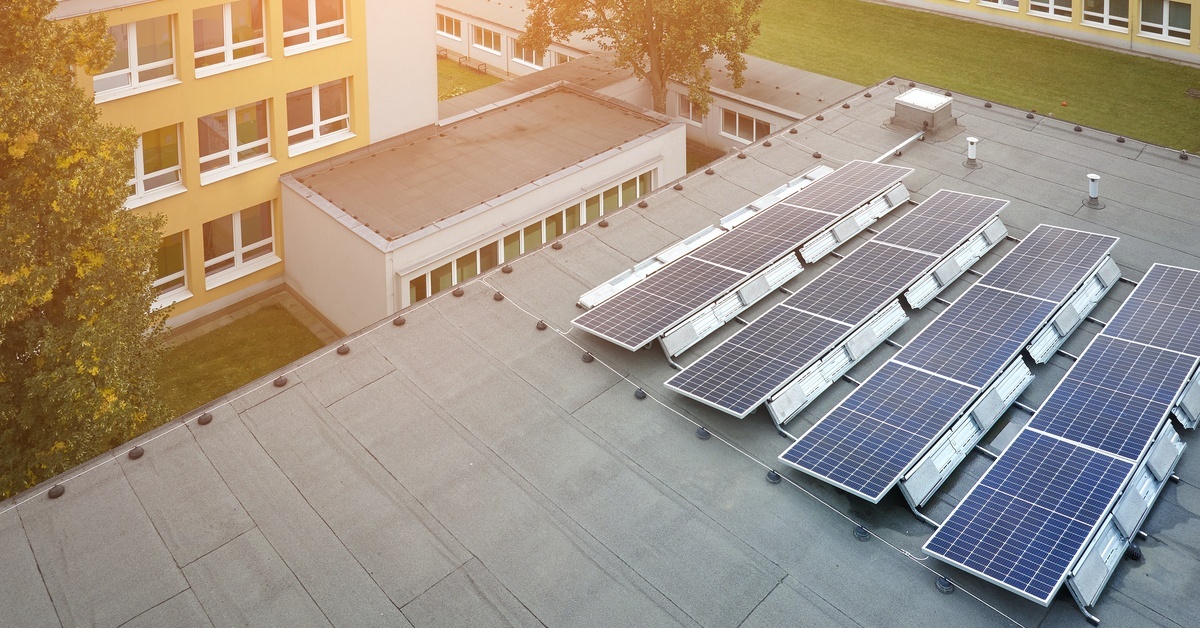Aug 18th 2025
School-Based Solar Power Systems for Electricity & Education
With the rise of energy costs for schools, solutions are needed for educational institutions to continue functioning effectively. Solar energy is one of the leading solutions to reducing power costs for schools, and can also be an educational opportunity for students.
Educational facilities consume commercial energy across the United States, making them a prime candidate for solar installations. Beyond the financial benefits, students can observe renewable energy in action. Integrating a school’s current power system with solar power can provide better electricity and engaging educational opportunities for all students.
Understanding School-Based Solar Power Systems
School solar installations are similar to other projects in terms of technology. The equipment consists of photovoltaic (PV) panels mounted on rooftops, parking structures, or dedicated ground areas. These systems convert sunlight directly into electricity through semiconductor materials that generate current when exposed to solar radiation.
Most educational solar systems connect to the electrical grid through net metering arrangements. During peak sunlight hours, schools can generate more energy than the building needs and then feed excess power back into the grid. This creates energy credits that offset consumption during evening hours or cloudy periods.
Key Components of Educational Solar Systems
Solar panels are a key component of the solar power system. High-efficiency photovoltaic modules can withstand harsh weather conditions and maintain optimal performance over decades of usage. From there, the energy collected by the panels moves into inverters that convert it into a compatible form that can power the school's electrical system.
Once the energy has been moved into the system, it is important for the school to monitor the energy production process. Real-time data collection platforms can help track energy production, consumption patterns, and system performance metrics. Combined with safety equipment like disconnect switches and surge protectors, faculty can monitor the systems without any struggles throughout the school year.

Financial Benefits for Educational Institutions
Solar installations deliver substantial cost savings that directly impact school budgets. Rather than spending large portions of their budgets on electrical costs, administrators can use those funds to support other areas and improve the school.
Federal tax incentives and state rebates can help with the initial installation costs for the solar project, reducing the stress on that school year's budget. Many schools utilize power purchase agreements (PPAs) or solar leases that require a minimal upfront investment while providing immediate savings.
Long-term financial projections show that after 6 to 10 years, the solar power system will pay for itself and continue to generate nearly free electricity thereafter. These predictable costs can help administrators plan budgets while protecting themselves against utility rate increases.
Financing Options for Schools
Schools can finance the installation through various methods. With direct purchases, the school would outright own the system and could maximize long-term savings and take advantage of any available tax incentives. This also comes with the added costs of repairs or replacements throughout the solar panel's lifespan.
Power purchase agreements are held between third-party developers that install and maintain the system for the school. The facility would still enjoy electricity at a reduced cost during the time of this agreement.
Solar leases are a lease between another party and the school that allows the school to use the solar panels for a fixed monthly payment that is usually lower than previous utility bills. It also alleviates concerns about cost increases that could affect the regular school budget.
Municipal bonds are popular for public schools that can issue bonds specifically for renewable energy projects, spreading costs over extended periods. All of these methods come with considerations that each school would need to consider before finalizing the project details.
Educational Opportunities and STEM Integration
Solar installations transform abstract scientific concepts into tangible learning experiences. Students can analyze real data from their school's system, understanding energy production patterns, weather impacts, and efficiency calculations.
Science classes can use solar data to explore different principles throughout the school year and showcase real-world examples to all the students. Other courses, like math, can incorporate lessons on analyzing data and graphing information collected from the solar panels.
Environmental science programs benefit enormously from access to live renewable energy data. Students can calculate carbon footprint reductions, compare fossil fuel alternatives, and understand climate change mitigation strategies through direct observations. All of these initiatives combined can showcase the real-world applications of STEM fields to them.

Curriculum Integration Strategies
Teachers and administrators can integrate a variety of strategies to introduce students to the applications of solar labels. One option is real-time data analysis, where students monitor daily energy production and consumption patterns from the solar panels. They can use this to help students learn how to identify trends and anomalies.
Students can also do environmental impact studies to calculate emissions reductions and compare them to renewable and traditional energy sources. For more math-based strategies, they can evaluate project costs, savings projections, and return on investment calculations.
Implementation Considerations for Schools
Successful solar projects require careful planning and stakeholder engagement. Site assessments evaluate roof conditions, shading patterns, and electrical infrastructure capacity. Professional engineers determine optimal system sizing based on historical energy usage and available installation space.
Administrative approval processes involve school boards, facilities management, and often community input. Clear communication about project benefits, costs, and educational opportunities helps build support among all stakeholders.
Site Assessment Factors
Installation managers must evaluate schools to determine if they have the right structures in place for the installation process. Structural integrity is paramount for the safe installation and operation of solar projects. This includes roof age, condition, and its load-bearing capacity to determine the system sizing options.
Shading analysis also needs to be conducted to identify any obstacles that block sunlight during peak production hours. Possible obstructions include trees, other buildings, and equipment. Once these tests have been done, the school must follow local regulations and permitting processes to begin the project and start harnessing renewable energy.
Building a Sustainable Future Through Education
School-based solar power systems represent more than infrastructure improvements; they're investments in environmental education and community sustainability. Students who learn alongside renewable energy systems develop a deeper understanding of climate solutions and possible future careers in the sustainable energy sector.
Proper installation processes must be followed for schools to build them, and safety features such as placards and labels must be prioritized during the building process. Regardless of where your solar project is, engraved solar placards from Get Solar Labels can help your solar project maintain safety for an affordable price.
With our quick turnaround, we can help you keep your solar project safe. Don’t wait to prioritize the proper labels for your solar project. Contact us today for more information on our solar placards.

